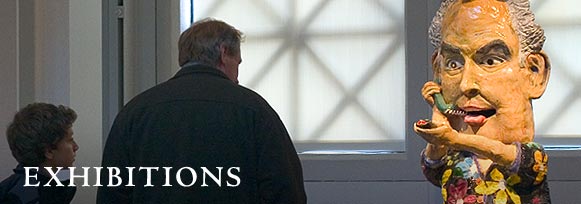Exhibition Schedule
MAJOR EXHIBITIONS ON VIEW
Myth, Allegory, and Faith: The Kirk Edward Long Collection of Mannerist Prints
Through June 20, 2016
Pigott Family Gallery
Selected from the Kirk Edward Long collection of 16th-century prints, this exhibition illuminates the development of the 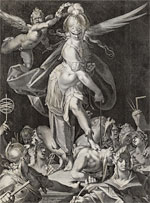 Mannerist style in Italy, traces its dissemination and adaptation for both secular and religious purposes, and follows its eventual transformation into the Baroque style at the end of the century. The exhibition features more than 180 engravings, etchings, woodcuts, and chiaroscuro woodcuts by such renowned artists as Federico Barocci, Parmigianino, Hendrick Goltzius, and Annibale Carracci, and by such famous printmakers as Marcantonio Raimondi, Giorgio Ghisi, and Cornelis Cort. Learn more IMAGE: Aegidius Sadeler II (Flanders, c. 1570–1629) after Bartolomeus Spranger (Flanders, 1546–1611), Wisdom Conquers Ignorance, c. 1600. Engraving. Lent by Kirk Edward Long
Mannerist style in Italy, traces its dissemination and adaptation for both secular and religious purposes, and follows its eventual transformation into the Baroque style at the end of the century. The exhibition features more than 180 engravings, etchings, woodcuts, and chiaroscuro woodcuts by such renowned artists as Federico Barocci, Parmigianino, Hendrick Goltzius, and Annibale Carracci, and by such famous printmakers as Marcantonio Raimondi, Giorgio Ghisi, and Cornelis Cort. Learn more IMAGE: Aegidius Sadeler II (Flanders, c. 1570–1629) after Bartolomeus Spranger (Flanders, 1546–1611), Wisdom Conquers Ignorance, c. 1600. Engraving. Lent by Kirk Edward Long
Richard Diebenkorn: The Sketchbooks Revealed
Through August 22, 2016
Marie Stauffer Sigall Gallery
This exhibition presents the sketchbooks of celebrated 20th-century painter Richard Diebenkorn—Stanford’s most accomplished and recognized graduate in art. On display for the first time, the 29 books span 50 years of the artist's career and contain 1,045 drawings. The extraordinary sketchbooks were gifted to the Cantor by Phyllis Diebenkorn, the artist’s widow.
Learn more IMAGE: Richard Diebenkorn (U.S.A., 1922-1993), Untitled from Sketchbook #10, page 15, 1943-1993.Gouache and crayon on paper. Cantor Arts Center collection, Gift of Phyllis Diebenkorn, 2014.10.17. © The Richard Diebenkorn Foundation
Edward Hopper: New York Corner
Through August 22, 2016
Marie Stauffer Sigall Gallery
The exhibition showcases the painting New York Corner and contextualizes it by grouping works from the mus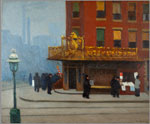 eum’s collection into several art-object-based “conversations.” These constellations point to the kinds of artistic practice that preceded the painting’s creation; showcase concurrent work, both similar and different, by Hopper’s contemporaries; and present the kinds of practice that followed.
eum’s collection into several art-object-based “conversations.” These constellations point to the kinds of artistic practice that preceded the painting’s creation; showcase concurrent work, both similar and different, by Hopper’s contemporaries; and present the kinds of practice that followed.
IMAGE: Edward Hopper (U.S.A., 1882–1967), New York Corner (Corner Saloon), 1913. Oil on canvas. Museum purchase made possible by the Halperin Art Acquisition Fund, an anonymous estate, Roberta & Steve Denning, Susan & John Diekman, Jill & John Freidenrich, Deedee & Burton McMurtry, Cantor Membership Acquisitions Fund, an anonymous acquisitions fund, Pauline Brown Acquisitions Fund, C. Diane Christensen, an anonymous donor, Modern & Contemporary Art Acquisitions Fund, and Kazak Acquisitions Fund
Red Horse: Drawings of the Battle of the Little Bighorn
Through May 9, 2016
Ruth Levison Halperin Gallery
This exhibition presents 12 ledger drawings by Red Horse, a Minneconjou Lakota Sioux warrior who fought a gainst Custer and the 7th Cavalry at the Battle of the Little Bighorn in 1876. Selected from a group of 42 drawings that chronicle the battle, the images depict scenes such as combat on horseback, wounded and dead warriors and soldiers, and Native Americans leaving the battlefield. The exhibition brings together key collaborators from Stanford and its communities to explore these indigenous-centered illustrations from diverse perspectives. Taking an interdisciplinary approach, the exhibition highlights the dynamic ways Red Horse’s drawings continue to function as an artist’s narrative of this important moment in American and Native American history. Learn more IMAGE: Red Horse (Minneconjou Lakota Sioux, 1822-1907), Untitled from the Red Horse Pictographic Account of the Battle of the Little Bighorn (detail), 1881. Graphite, colored pencil, and ink. NAA MS 2367A, 08570700. National Anthropological Archives, Smithsonian Institution
gainst Custer and the 7th Cavalry at the Battle of the Little Bighorn in 1876. Selected from a group of 42 drawings that chronicle the battle, the images depict scenes such as combat on horseback, wounded and dead warriors and soldiers, and Native Americans leaving the battlefield. The exhibition brings together key collaborators from Stanford and its communities to explore these indigenous-centered illustrations from diverse perspectives. Taking an interdisciplinary approach, the exhibition highlights the dynamic ways Red Horse’s drawings continue to function as an artist’s narrative of this important moment in American and Native American history. Learn more IMAGE: Red Horse (Minneconjou Lakota Sioux, 1822-1907), Untitled from the Red Horse Pictographic Account of the Battle of the Little Bighorn (detail), 1881. Graphite, colored pencil, and ink. NAA MS 2367A, 08570700. National Anthropological Archives, Smithsonian Institution
Missing Persons
Through March 21, 2016
Freidenrich Family Gallery
The diverse works in this exhibition, including some 50 photographs, prints, artist books, and historical ephemera, dramatize the loss of those made missing by time, deat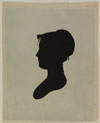 h, disaster, politics, or artistic composition. A silhouette portrait by Raphaelle Peale records the trace of a person’s profile by capturing a momentary shadow. Self-portraits by Lee Friedlander and Laura Volkerding play with shadow, absence, and blankness, suggesting the presence of a person who is not directly on view. Contemporary artists such as Glenn Ligon, Kara Walker, and Ester Hernandez address the missing through the lenses of history and oppression. Learn more IMAGE: Raphaelle Peale (U.S.A., 1774–1825), Portrait of H.L., c. 1820. Silhouette cutout. Committee for Art Acquisitions Fund, 1978.4
h, disaster, politics, or artistic composition. A silhouette portrait by Raphaelle Peale records the trace of a person’s profile by capturing a momentary shadow. Self-portraits by Lee Friedlander and Laura Volkerding play with shadow, absence, and blankness, suggesting the presence of a person who is not directly on view. Contemporary artists such as Glenn Ligon, Kara Walker, and Ester Hernandez address the missing through the lenses of history and oppression. Learn more IMAGE: Raphaelle Peale (U.S.A., 1774–1825), Portrait of H.L., c. 1820. Silhouette cutout. Committee for Art Acquisitions Fund, 1978.4
CONTINUING EXHIBITIONS ON VIEW
Speed and Power
Through March 21, 2016
Lynn Krywick Gibbons Gallery
People living in the 20th century witnessed an unprecedented—and often frightening—acceleration in the pace of everyday life, wrought by the introduction of a host of new travel technologies. Starting with Europe’s big cities and traveling on across the Atlantic, the exhibition will explore the many ways that trains, planes, and automobiles have shaped modern urban life and how artists have integrated the interrelated themes of speed and power into their work. Guest curator: Mark Braude, lecturer, Stanford University. IMAGE: Garry Winogrand (U.S.A., 1928–1984), Cape Kennedy, Florida, 1969. Gelatin silver print. Cantor Arts Center collection, Gift of Patrick J. Kealy, 1979.193.1. © The Estate of Garry Winogrand, courtesy Fraenkel Gallery, San Francisco
in the pace of everyday life, wrought by the introduction of a host of new travel technologies. Starting with Europe’s big cities and traveling on across the Atlantic, the exhibition will explore the many ways that trains, planes, and automobiles have shaped modern urban life and how artists have integrated the interrelated themes of speed and power into their work. Guest curator: Mark Braude, lecturer, Stanford University. IMAGE: Garry Winogrand (U.S.A., 1928–1984), Cape Kennedy, Florida, 1969. Gelatin silver print. Cantor Arts Center collection, Gift of Patrick J. Kealy, 1979.193.1. © The Estate of Garry Winogrand, courtesy Fraenkel Gallery, San Francisco
Warriors, Courtiers, and Saints: The Etchings of Jacques Callot
Through March 28, 2016
Gallery for Early European Art
During his brief career, Jacques Callot (France, 1592–1635) challenged the old assumption that printmakers we re incapable of inventing original compositions by creating elegant, expressive prints. Warriors, Courtiers, and Saints features a selection of 16 prints that demonstrate Callot’s remarkable range—from recording the horrors of war to rendering whimsical landscapes, formal courtly scenes, and somber religious subjects—all in his light and fluid style. IMAGE: Lucas Vosterman (the Netherlands, 1595–1675), Portrait of Jacques Callot, c. 1645. Etching and engraving. Robert M. Loeser Collection, 1944.2.60
re incapable of inventing original compositions by creating elegant, expressive prints. Warriors, Courtiers, and Saints features a selection of 16 prints that demonstrate Callot’s remarkable range—from recording the horrors of war to rendering whimsical landscapes, formal courtly scenes, and somber religious subjects—all in his light and fluid style. IMAGE: Lucas Vosterman (the Netherlands, 1595–1675), Portrait of Jacques Callot, c. 1645. Etching and engraving. Robert M. Loeser Collection, 1944.2.60
Word as Image: Highlights from the Marmor Collection
Through April 4, 2016
Patricia Rebele Gallery
Words have figured in various guises throughout the history of  art, frequently appearing in liturgical contexts including illuminated manuscripts in the Middle Ages or decoratively ornamented Qu’ranic writings from the Ottoman Empire. Throughout the 20th century, artists have used texts and lettering to reference a newly prevalent culture of mass production, to blur the lines between popular culture and fine art, and to upend seemingly simple meanings. IMAGE: Edward Ruscha (U.S.A., b. 1937), Excuse Me I Didn't Mean to Interrupt, 1975. Lithograph. Cantor Arts Center collection, Gift of Ramona C. and Nathan Oliveira, 1977.204.13
art, frequently appearing in liturgical contexts including illuminated manuscripts in the Middle Ages or decoratively ornamented Qu’ranic writings from the Ottoman Empire. Throughout the 20th century, artists have used texts and lettering to reference a newly prevalent culture of mass production, to blur the lines between popular culture and fine art, and to upend seemingly simple meanings. IMAGE: Edward Ruscha (U.S.A., b. 1937), Excuse Me I Didn't Mean to Interrupt, 1975. Lithograph. Cantor Arts Center collection, Gift of Ramona C. and Nathan Oliveira, 1977.204.13
Wanting More: Picturing the Rise of Consumer Culture
Through April 4, 2016
Rowland K. Rebele Gallery
The artists represented in this exhibition used  their cameras to look askance at the expansion of consumer culture in the 20th century. Some inspect the products of mass manufacture intensely, others take a close look at the advertising systems invented to move goods quickly from factory to home. Together, these works highlight the influx of prefabricated objects and marketing campaigns over the last century and point to their underpinning promise (so often unfulfilled) of a prosperous life. IMAGE: Frank Paulin (U.S.A., b. 1926), Grant’s Bar, New York, 1956. Gelatin silver print. Cantor Arts Center collection, Gift of Bruce and Silke Silverstein, 2010.6
their cameras to look askance at the expansion of consumer culture in the 20th century. Some inspect the products of mass manufacture intensely, others take a close look at the advertising systems invented to move goods quickly from factory to home. Together, these works highlight the influx of prefabricated objects and marketing campaigns over the last century and point to their underpinning promise (so often unfulfilled) of a prosperous life. IMAGE: Frank Paulin (U.S.A., b. 1926), Grant’s Bar, New York, 1956. Gelatin silver print. Cantor Arts Center collection, Gift of Bruce and Silke Silverstein, 2010.6
Showing Off: Identity and Display in Asian Costume
Through May 23, 2016
Madeleine H. Russell Gallery
Fashion is a form of language. What we wear b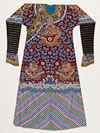 roadcasts critical information about us and serves as a visible indicator of social rank, profession, ethnicity, or status. This exhibition of Asian textiles and other works from the Cantor’s collection demonstrates how costume and objects of personal adornment functioned as a method of identification and display from the late 18th century to today. Ranging from Qing court costumes to Indonesian textiles, the selection on view spotlights visual symbols while showcasing rarely displayed garments. IMAGE: Artist unknown (China, Qing dynasty), Man’s Dragon Robe, c. 1821–50. Silk tapestry with metal-wrapped threads. Cantor Arts Center collection, Gift of Colonel and Mrs. John Young, 1976.75
roadcasts critical information about us and serves as a visible indicator of social rank, profession, ethnicity, or status. This exhibition of Asian textiles and other works from the Cantor’s collection demonstrates how costume and objects of personal adornment functioned as a method of identification and display from the late 18th century to today. Ranging from Qing court costumes to Indonesian textiles, the selection on view spotlights visual symbols while showcasing rarely displayed garments. IMAGE: Artist unknown (China, Qing dynasty), Man’s Dragon Robe, c. 1821–50. Silk tapestry with metal-wrapped threads. Cantor Arts Center collection, Gift of Colonel and Mrs. John Young, 1976.75
Contemporary Perspectives on the Battle of the Little Bighorn
Through June 13, 2016
Rehmus Family Gallery
Indigenous undergraduates Sarah Sadlier and I sabella Shey Robbins will lead a fall, student-initiated course that will yield an exhibition designed to accompany the Cantor’s major show Red Horse: Drawings of the Battle of the Little Bighorn. The student-curated exhibition will include works by contemporary indigenous artists and offer their modern-day perspectives on this historic battle as well as on other indigenous events and issues. Karen Biestman, Associate Dean and Director of Stanford’s Native American Cultural Center, will serve as faculty sponsor. IMAGE: Dwayne Wilcox (Oglala Lakota, b. 1957), Budweiser Killed More Indians than Custer, 2010. Colored pencil and ink. Courtesy of the artist
sabella Shey Robbins will lead a fall, student-initiated course that will yield an exhibition designed to accompany the Cantor’s major show Red Horse: Drawings of the Battle of the Little Bighorn. The student-curated exhibition will include works by contemporary indigenous artists and offer their modern-day perspectives on this historic battle as well as on other indigenous events and issues. Karen Biestman, Associate Dean and Director of Stanford’s Native American Cultural Center, will serve as faculty sponsor. IMAGE: Dwayne Wilcox (Oglala Lakota, b. 1957), Budweiser Killed More Indians than Custer, 2010. Colored pencil and ink. Courtesy of the artist
Into the Forest: Landscape as Subject and Studio in 19th-Century France
Through July 4, 2016
Robert Mondavi Family Gallery
This installation of prints, drawings, and photographs explores how French artists depicted the landscape in the modern age and approached making art “en plein air” (in the open air). The phenomenon of making art outdoors took shape in the early decades of the 19th century with the experimental Barbizon School of painters and fully flourished under the Impressionists. Exhibition highlights include photographs by painter James Tissot (1836–1902), a rare cliché-verre—a drawing reproduced using a photographic process—by Jean-Baptiste Camille Corot (1796–1875), and prints by Camille Pissarro (1831–1903). IMAGE: Jean-Baptise Camille Corot (1796–1875), Souvenir of Ostia, 1855. Cliché-verre. Committee for Art Acquisitions Fund, 1987.34
how French artists depicted the landscape in the modern age and approached making art “en plein air” (in the open air). The phenomenon of making art outdoors took shape in the early decades of the 19th century with the experimental Barbizon School of painters and fully flourished under the Impressionists. Exhibition highlights include photographs by painter James Tissot (1836–1902), a rare cliché-verre—a drawing reproduced using a photographic process—by Jean-Baptiste Camille Corot (1796–1875), and prints by Camille Pissarro (1831–1903). IMAGE: Jean-Baptise Camille Corot (1796–1875), Souvenir of Ostia, 1855. Cliché-verre. Committee for Art Acquisitions Fund, 1987.34
Mining the Ancient
Through August 29, 2016
Oshman Family Gallery
Artists throughout the ages have looked to the past to unearth inspiration. Mining the Ancient presents the work of five contemporary artists who take their cue from the lan guage of the ancient and find inspiration for their sculptural practices in fragments of the past. Juxtaposed with key historical works from the Cantor’s ancient art collection, this group exhibition explores the ways in which some of the most recent art practice of today creates fantastic dialogues with some of the oldest art objects in our civilization’s history. IMAGE: Kris Martin (Belgium b. 1972), Sommerferienewigkeitsgefuhl, 2014. Bronze. Collection of Kaitlyn and Mike Krieger. Image Courtesy Sies + Höke, Düsseldorf, Photographed by Achim Kukulies, Düsseldorf
guage of the ancient and find inspiration for their sculptural practices in fragments of the past. Juxtaposed with key historical works from the Cantor’s ancient art collection, this group exhibition explores the ways in which some of the most recent art practice of today creates fantastic dialogues with some of the oldest art objects in our civilization’s history. IMAGE: Kris Martin (Belgium b. 1972), Sommerferienewigkeitsgefuhl, 2014. Bronze. Collection of Kaitlyn and Mike Krieger. Image Courtesy Sies + Höke, Düsseldorf, Photographed by Achim Kukulies, Düsseldorf
Figuration/Abstraction: Highlights from the Collection
Through August 29, 2016
Freidenrich Family Gallery
Dual installations reflect the split between figuration and abstraction that began in the early 1900s and grew over the course of the 20th century. The chasm between these two styles was not impassable, though—many artists made work that could slip fluidly from one category to the next, including celebrated Bay Area painter Richard Diebenkorn, whose work is featured in both installations. Figuration/Abstraction illuminates how even within individual artists’ careers, the choice between working abstractly or figuratively was not always definitive. IMAGE: Roger Shimomura (U.S.A., b. 1939), Lush Life #2, 2008. Acrylic on canvas. Cantor Arts Center collection, Gift of Marilynn and Carl Thoma, 2010.97
Who We Be
March 30–June 27, 2016
Lynn Krywick Gibbons Gallery
This exhibition takes a close examination of visual culture—particularly images, works, and ideas in the contemporary arts, justice movements, and popular culture to  reflect on North American demographic and cultural change and cultural politics—since 1965. From the Watts uprising to the #BlackLivesMatter movement, from multiculturalism through hiphop to the reception of postidentity art, we explore the questions: How do Americans see race now? Do we see each other any more clearly than before? Inspired by awardwinning journalist and Stanford faculty Jeff Chang’s 2014 book Who We Be: The Colorization of America, this exhibition combines selections from the Cantor’s collection, objects and artwork from Stanford’s Institute for Diversity in the Arts, and loaned artworks specific for this project. IMAGE: Garry Winogrand (U.S.A., 1928–1984), Santa Monica, California, 1978 from the portfolio Women are Better than Men. Not Only Have They Survived, They Do Prevail,1982. Gelatin silver print. Cantor Arts Center collection, Gift of Patrick J. Kealy, 1983.155.5. © The Estate of Garry
reflect on North American demographic and cultural change and cultural politics—since 1965. From the Watts uprising to the #BlackLivesMatter movement, from multiculturalism through hiphop to the reception of postidentity art, we explore the questions: How do Americans see race now? Do we see each other any more clearly than before? Inspired by awardwinning journalist and Stanford faculty Jeff Chang’s 2014 book Who We Be: The Colorization of America, this exhibition combines selections from the Cantor’s collection, objects and artwork from Stanford’s Institute for Diversity in the Arts, and loaned artworks specific for this project. IMAGE: Garry Winogrand (U.S.A., 1928–1984), Santa Monica, California, 1978 from the portfolio Women are Better than Men. Not Only Have They Survived, They Do Prevail,1982. Gelatin silver print. Cantor Arts Center collection, Gift of Patrick J. Kealy, 1983.155.5. © The Estate of Garry
Blood in the Sugar Bowl
April 6–August 15, 2016
This exhibition focuses on sugar plantation slavery during the peak of the sugar trade, the late 18th–mid-19th century. On display are sugar bowls from the Cantor’s collection, H enry Corbould’s illustration Fashionable Women Pouring Tea, James Gillray’s caricature The Anti-Saccharites, several volumes from Stanford University Libraries Special Collections including James Hakewill’s beautiful plantation views from his 1821 Picturesque Tour of the Island of Jamaica and William Blake’s depictions of slave torture in his 1777 Narrative, of a five years’ expedition, against the revolted Negroes of Surinam. Personalizing the slave narrative are Benjamin M’Mahon’s Jamaica Plantership and other audio excerpts of texts written by slaves and sugar plantation employees. D. R. Wakefield’s 2004 series Resistance Is Useless: Portraits of Slaves from the British West Indies is also on display. Student curator: Stanford PhD candidate and Mellon Curatorial Research Assistant Rachel Newman. IMAGE: Josiah Wedgwood (England, 1730–1795), Covered Sugar Bowl, c. 1785-95. Stoneware. Cantor Arts Center collection, Committee for Art Acquisitions Fund, 1989.154.a-b
enry Corbould’s illustration Fashionable Women Pouring Tea, James Gillray’s caricature The Anti-Saccharites, several volumes from Stanford University Libraries Special Collections including James Hakewill’s beautiful plantation views from his 1821 Picturesque Tour of the Island of Jamaica and William Blake’s depictions of slave torture in his 1777 Narrative, of a five years’ expedition, against the revolted Negroes of Surinam. Personalizing the slave narrative are Benjamin M’Mahon’s Jamaica Plantership and other audio excerpts of texts written by slaves and sugar plantation employees. D. R. Wakefield’s 2004 series Resistance Is Useless: Portraits of Slaves from the British West Indies is also on display. Student curator: Stanford PhD candidate and Mellon Curatorial Research Assistant Rachel Newman. IMAGE: Josiah Wedgwood (England, 1730–1795), Covered Sugar Bowl, c. 1785-95. Stoneware. Cantor Arts Center collection, Committee for Art Acquisitions Fund, 1989.154.a-b
Intimate Frontiers: The Male Gaze in Fin-de-Siècle Vienna
April 13–August 8, 2016
Patricia S. Rebele Gallery
Using the Cantor’s extensive collection of photographs, sketches, and decorative objects from fin-de-siècle  Vienna, this exhibition explores how male artists manipulated images of women in an attempt to control and define women’s roles and status. During this time, norms about women’s intimate relationships with lovers and friends and the structure of the interior, domestic sphere were greatly shifting. The exhibition presents photographic prints by Heinrich Kühn, numerous sketches by Oskar Kokoschka, decorative works from 1883 Austria, works by Max Kurzwell, and more. Student curator: Stanford undergraduate and Cantor Scholar Alex Zivkovic. IMAGE: Heinrich Kühn (Austria, b. Germany, 1866–1944), Miss Mary Warner in her Bedroom, c. 1910–14. Gum-bichromate print. Committee for Art Acquisitions Fund, 1983.265
Vienna, this exhibition explores how male artists manipulated images of women in an attempt to control and define women’s roles and status. During this time, norms about women’s intimate relationships with lovers and friends and the structure of the interior, domestic sphere were greatly shifting. The exhibition presents photographic prints by Heinrich Kühn, numerous sketches by Oskar Kokoschka, decorative works from 1883 Austria, works by Max Kurzwell, and more. Student curator: Stanford undergraduate and Cantor Scholar Alex Zivkovic. IMAGE: Heinrich Kühn (Austria, b. Germany, 1866–1944), Miss Mary Warner in her Bedroom, c. 1910–14. Gum-bichromate print. Committee for Art Acquisitions Fund, 1983.265
An Oasis in Glass
April 13–August 8, 2016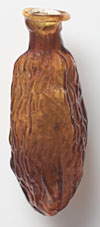
Rowland K. Rebele Gallery
This exhibition showcases 4th-century mosaics, beads, flasks, and other glass objects created during the Roman occupation of Syria and Egypt. Displayed in a space that replicates the desert’s dunes and wide expanses, each object serves as a kind of tiny experiential oasis what with light boxes amplifying the works’ sparkle and transparency. The show also incorporates themes from classical Arabic poetry. Student curator: Stanford undergraduate and Cantor Scholar Evelina Yarmit. IMAGE: Artist unknown (Roman, Syria), Date-shaped Flask, 1st–2nd century. Mold-blown glass. Cantor Arts Center collection, Stanford Family Collections, JLS.17275
Soulmaker: The Times of Lewis Hine
May 21–September 26, 2016
Ruth Levison Halperin Gallery
One hundred years ago, the photographer Lewis Hine travelled to mills and factories in New England and the South, photographing child laborers. His photographs are among the most haunting images of children ever made. In this exhibition, a beautiful selection of Hine’s child-labor photographs is juxtaposed with stunning contemporary photographs taken by photographer Jason Francisco (Stanford M.F.A., ’89) of those same mill and factory sites as they look now. Guest curator: Alexander Nemerov, Carl and Marilynn Thoma Provostial Professor in the Arts and Humanities and Chair of the Department of Art & Art History, Stanford University.
California: The Art of Water
July 13–November 28, 2016
Pigott Family Gallery
This major exhibition is devoted to artistic portrayals of California’s most precious—and currently scarce—resource. It presents more than 70 works by eminent artists including Ansel Adams, Albert Bierstadt, David Hockney, Richard Misrach, and Carleton Watkins, and features images from a variety of regions around the state, during the Gold Rush to the present. The exhibition offers a compelling aesthetic experience set within debates about water that have spanned the 19th century to the present. It is also accompanied by an array of public programs designed to raise awareness and appreciation of California’s complicated water issues. IMAGE: William Keith (U.S.A., b. Scotland, 1838–1911), Upper Kern River, 1876. Oil on canvas. Cantor Arts Center collection, Stanford Family Collections. Conservation supported by the Lois Clumeck Fund, JLS.12057.
presents more than 70 works by eminent artists including Ansel Adams, Albert Bierstadt, David Hockney, Richard Misrach, and Carleton Watkins, and features images from a variety of regions around the state, during the Gold Rush to the present. The exhibition offers a compelling aesthetic experience set within debates about water that have spanned the 19th century to the present. It is also accompanied by an array of public programs designed to raise awareness and appreciation of California’s complicated water issues. IMAGE: William Keith (U.S.A., b. Scotland, 1838–1911), Upper Kern River, 1876. Oil on canvas. Cantor Arts Center collection, Stanford Family Collections. Conservation supported by the Lois Clumeck Fund, JLS.12057.
| RELATED LINKS |
|---|
| Exhibition Archives |
| Docent Tours |
| Exhibition Catalogues |
| Coming Soon |
Rodin! The Complete Stanford Collection
Read More



